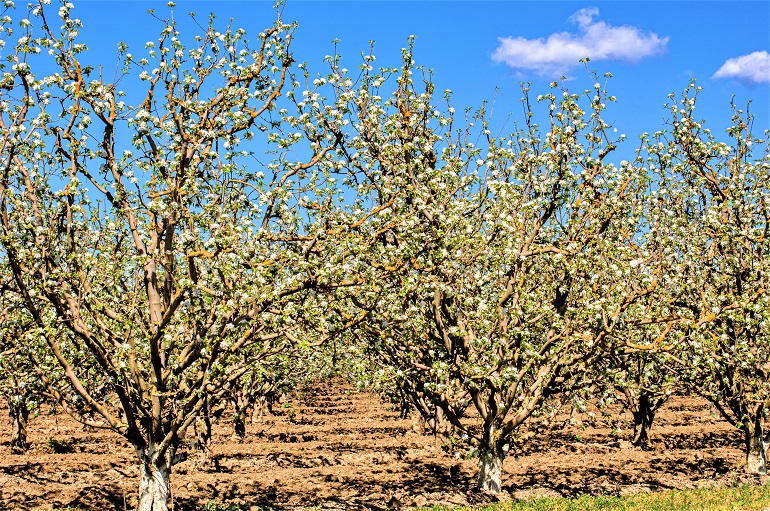How to Propagate and Pollinate Apricot Trees

This post is also available in:
This post is also available in:
![]() Español (Spanish)
Español (Spanish) ![]() Français (French)
Français (French) ![]() हिन्दी (Hindi)
हिन्दी (Hindi) ![]() العربية (Arabic)
العربية (Arabic) ![]() Ελληνικά (Greek)
Ελληνικά (Greek) ![]() Português (Portuguese (Brazil))
Português (Portuguese (Brazil))
Apricot Propagation
The apricot tree is mainly propagated vegetatively to maintain the variety purity and, as a result, the desirable characteristics. Trees can be propagated by grafting (T-grafting) or budding of the wanted variety (scion) on 1-2 years old rootstocks (genetically distinct variety). Grafting is a commonly used technique by which we join together parts from two different plants so that they will grow as a single plant. The upper part of the first plant is called a scion and grows on the root system of the second plant, called the rootstock. As a rootstock, the seedling of an apricot or plum plant can be used. Sometimes, peach seedlings may be used as rootstocks, but some incompatibility problems exist. The selection of the rootstock variety is very important since it will affect the tree size, the resistance to soil-born pathogens, and the draught and frost tolerance of the grafted tree. Eventually, we have a plant that combines all the advantages of its different components. T grafting can be performed from early spring as soon as the bark can be easily detached, but as the most suitable period, we consider summer and autumn. You are advised to purchase your grafted trees from a legitimate plant nursery to ensure the variety, purity, and plants’ health.
Apricot Tree Pollination
Most commercial varieties of apricot are self-fertile. However, cross-pollination is usually preferred since it may result in higher yields. Moreover, there are also some variety exceptions that are (partially) self-sterile and require cross-pollination to set fruits. Some of the varieties that are not self-fertile are listed below:
- Varieties mainly used in America: Vivagold, Riland, Perfection, Orange red, and others
- Varieties mainly used in Europe: Tsunami, Spring blush, Primado, Bebeco, Wonder Cot, PinCot, Velazquez Fino, Pepito del Cura, Moniqui Fino, and others.
- Others: Acqua del Serino, Morocco, Patterson, Bellidieu, Cafona, Pisana, Goldcot, Selene, Tilton, Valenciano, Modesto, etc
These varieties need to be planted at a close distance to compatible pollinizer varieties (1 or more). For a higher success rate, the pollinizer apricot varieties’ trees should be 15-25% of the total number of trees in the orchard. Most producers prefer to plant one row of the pollinizer variety for every 3 rows of the main variety to facilitate cross-pollination.
The honeybee is the primary insect that can facilitate the cross-pollination of Apricot trees. Most Apricot growers place 5-7 strong and healthy honey bee colonies per hectare. To protect the bees (and other beneficial insects), it is vital not to spray with pesticides during the blooming period of the apricots (especially with nonselective products). The pollination efficiency may drop when the weather is cold, rainy, cloudy, or windy since the bees do not forage well in such conditions. This is a significant problem in colder areas and with very early flowering varieties. In this case, the fruit formation will be reduced or even limited. Decreased fruit yield may also be the result of pollen incompatibility. This means that the varieties that have been planted together are not fully compatible or/and flowering is asynchronous. Such a problem is tough and costly to be corrected after the trees have been established in the field. For this reason, it is essential to make your own research and get advice from your local plant nursery and agronomist before you choose and plant the apricot varieties (choose your main variety and find the best pollinizer varieties compatible with it). For trees that grow under cover, complementary hand pollination may be needed. Finally, except for the above-mentioned reasons, the apricots may fail to bear fruits in case of frost during flowering (temperature of -1 °C or 30 °F will kill the flowers), heavy pruning (removal of too many flower buds), and poor training (horizontal orientation of the branches) and excessive nitrogen fertilization.
References
- https://polk.extension.wisc.edu/files/2014/02/Rootstocks-for-Fruit-in-WI-A3561.pdf
- https://hort.ifas.ufl.edu/database/lppi/sp301.shtml
- https://extension.unh.edu/sites/default/files/migrated_unmanaged_files/Resource003729_Rep5311.pdf
- https://www.plantgrower.org/uploads/6/5/5/4/65545169/growing-plums-in-wi.pdf
- https://journals.ashs.org/downloadpdf/journals/hortsci/28/2/article-p148.pdf
- https://extension.umd.edu/resource/tree-fruit-pollination
- https://www.researchgate.net/publication/
- http://omafra.gov.on.ca/english/crops/facts/02-035.htm#c
Apricot Tree Information and Varieties
Nutrition Value, Health Benefits, Uses, and Interesting facts about Apricot
Growing Apricot Trees for Profit
Apricot Soil Requirements, Soil preparation, and Planting
How to Propagate and Pollinate Apricot Trees
How to Train and Prune Apricot Trees
Apricot Trees Irrigation – How to water Apricot trees
Apricot Tree Fertilizer Requirements








































































